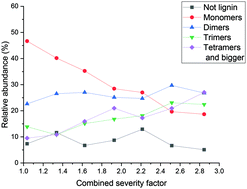Evaluation of process severity on the chemical composition of organosolv switchgrass lignins by using mass spectrometry†
Abstract
Organosolv treatment is an environmentally friendly fractionation method that affords a lignin stream with high purity. The severity of the treatment affects the chemical composition of the generated, very complex lignin degradation product mixtures. Understanding the effects of the process severity on the types and relative abundances of the individual compounds in the mixtures is of great importance for the optimization of the treatment and the development of downstream conversion processes. In this study, seven organosolv switchgrass lignin samples prepared at different reaction temperatures and using different acid concentrations and reaction times were initially analyzed by using high-resolution mass spectrometry with negative ion-mode electrospray ionization ((−)ESI HRMS). Fast pyrolysis coupled with negative ion-mode atmospheric pressure chemical ionization and HRMS (py/(−)APCI HRMS) was also used to characterize the lignin degradation products. This method generated similar data as (−)ESI HRMS. Lignin monomers and dimers were found to constitute the majority of compounds in the mixtures. High-performance liquid chromatography coupled with (−)ESI high-resolution multistage tandem mass spectrometry (HPLC/(−)ESI HRMSn) based on collision-activated dissociation (CAD) was employed to obtain structural information for the most abundant compounds as well as a β-O-4 dimer with a relatively low abundance in the organosolv lignin samples. The relative abundances of lignin–carbohydrate complexes were found to be high under mild organosolv treatment conditions but become low under moderate and harsh treatment conditions. As lignin compounds with β-O-4 linkages are not stable under acidic conditions, the relative abundances of these compounds were found to be very low. The relative amounts of lignin monomers decreased as the treatment severity increased while the relative abundances of lignin dimers, trimers, and bigger oligomers increased, possibly due to repolymerization reactions under the harsher treatment conditions.



 Please wait while we load your content...
Please wait while we load your content...